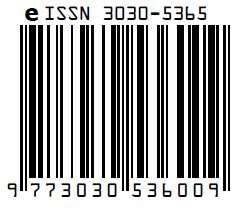Phytochemical Profile and Antimicrobial Activity of Citrus Medica (Limau Susu) Fruit Peels Extract
DOI:
https://doi.org/10.31674/ijbb.2024.v01i01.002Abstract
Citrus medica, also known as “Limau Susu” in Malaysia, is generally called a citron in English. Citrus medica is one of the four original citruses, and many of today's citrus varieties are descended from this variety. Six Citrus medica peel extracts were produced from this research using the maceration technique and percentage yield were calculated. Each different extraction procedure inevitably results in variances in biological activity. This study aimed to assess extraction procedures' impact on the yield and microbial activity of Citrus medica using the disc-diffusion method. In addition, GC-MS was carried out to identify additional components (qualitative). The phytochemical analysis of each extract was done to distinguish the chemical constituent between the extracts. Results show that both dry and fresh samples of the Citrus medica plant give percentage yield of methanol extract. Meanwhile, the hexane extract shows the highest anti-microbial activities due to the presence of 3 major compounds. The high antimicrobial activity is due to the presence of Oxacycloheptadec-8-en-2-one, 2-Cyclohexen-1-ol, and Terpineol as major compounds in the extract.
Keywords:
Citrus medica, Extraction Method, Antimicrobial Activity, GCMSReferences
Ballistreri, G., Fabroni, S., Romeo, F.V., Timpanaro, N., Amenta, M. and Rapisarda, P. (2019). Anthocyanins and Other Polyphenols in Citrus Genus: Biosynthesis, Chemical Profile, and Biological Activity. Polyphenols in Plants, pp.191–215. Available from: doi:10.1016/b978-0-12-813768-0.00014-1.
Bhuiya, M., Rasul, M., Khan, M., Ashwath, N., & Mofijur, M. (2020). Comparison of oil extraction between screw press and solvent (n-hexane) extraction technique from beauty leaf (Calophyllum inophyllum L.) feedstock. Industrial Crops and Products, 144, 112024. https://doi.org/10.1016/j.indcrop.2019.112024
Benazzouz, K., Belkahla, H., Hamiche, S., & Hattab, M. E. (2020). Effect of Citrus stubborn disease (Spiroplasma citri) on chemical composition of orange (Citrus sinensis (L) Osbeck) essential oil fruits. International Journal of Fruit Science, 20(sup3), S1360-S1372.
Chhikara, N., Kour, R., Jaglan, S., Gupta, P., Gat, Y. and Panghal, A. (2018). Citrus medica: nutritional, phytochemical composition and health benefits – a review. Food & Function, [online] 9(4), pp.1978–1992. Available from: doi:10.1039/c7fo02035j.
Chen, Y., Yao, F., Ming, K., Wang, D., Hu, Y., & Liu, J. (2016). Polysaccharides from traditional Chinese medicines: extraction, purification, modification, and biological activity. Molecules, 21(12), 1705.
Freakley, S. J., Dimitratos, N., Hutchings, G. J., Taylor, S. A., & Kiely, C. J. (2021). Methane Oxidation to Methanol in Water. Accounts of Chemical Research, 54(11), 2614–2623. https://doi.org/10.1021/acs.accounts.1c00129.
Hijazi, K., Joshi, C., & Gould, I. M. (2019). Challenges and opportunities for antimicrobial stewardship in resource-rich and resource-limited countries. Expert Review of Anti-infective Therapy, 17(8), 621-634.
Hidayati, E., Wardani, I., Susyanti, D., Mardianti, S., & Sudarma, I. (2020). Antimicrobial Assay and GC-MS Analysis of Leaves Extracts Medicinal Plant Senna hirsuta (L.). Antimicrobial Assay and GC-MS Analysis of Leaves Extracts Medicinal Plant Senna hirsuta (L.), 11(3), 215-219.
Juradin, S., Boko, I., Grubeša, I. N., Jozić, D., & Mrakovčić, S. (2019). Influence of harvesting time and maceration method of Spanish Broom (Spartium junceum L.) fibers on mechanical properties of reinforced cement mortar. Construction and Building Materials, 225, 243–255. https://doi.org/10.1016/j.conbuildmat.2019.07.207.
Liegeard, J., & Manning, L. (2020). Use of intelligent applications to reduce household food waste. Critical reviews in food science and nutrition, 60(6), 1048-1061.
NIST/EPA/NIH Mass Spectral Library with Search Program (Data Version: NIST 18, Software Version 2.0g.)
Oladipo, B., & Betiku, E. (2019). Process optimization of solvent extraction of seed oil from Moringa oleifera: An appraisal of quantitative and qualitative process variables on oil quality using D-optimal design. Biocatalysis and Agricultural Biotechnology, 20, 101187. https://doi.org/10.1016/j.bcab.2019.101187.
Santiago, B., & Feijoo, G. (2020). Identification of environmental aspects of citrus waste valorization into D-limonene from a biorefinery approach. Biomass & Bioenergy, 143, 105844. https://doi.org/10.1016/j.biombioe.2020.105844.
Singh, B., Singh, J. P., Kaur, A., & Yadav, M. P. (2021). Insights into the chemical composition and bioactivities of citrus peel essential oils. Food Research International, 143, 110231.
Zamakshshari, N.H., Ahmed, I.A., Didik, N.A.M. et al. Chemical profile and antimicrobial activity of essential oil and methanol extract from peels of four Durio zibethinus L. varieties. Biomass Conv. Bioref. 13, 13995–14003 (2023). https://doi.org/10.1007/s13399-021-02134-0





